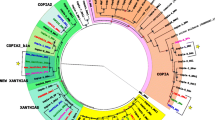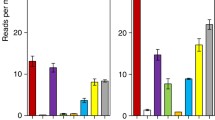Abstract
Thirty-three percent (228/682) of all long terminal repeat (LTR) retrotransposon sequences (LRSs) present in the sequenced Drosophila melanogaster genome were found to be located in or within 1000 bp of a gene. Recently inserted LTR retrotransposons are significantly more likely to be located in or within genes than are older, fragmented LTR retrotransposon sequences, indicating that most LRS-gene associations are selected against over evolutionary time. LRSs associated with conserved genes (homologenes) are especially prone to negative selection. In contrast, fragmented LRSs that have persisted in the genome over long spans of evolutionary time are preferentially associated with genes involved in signal transduction and other newly evolved functions.



Similar content being viewed by others
References
Adams MD, Celniker SE, Holt RA, et al. (2000) The genome sequence of Drosophila melanogaster. Science 287:2185–2195
Arkhipova I, Lyubomirskaya N, Ilyin Y (1995) Drosophila retrotransposons. Landers Press, Austin, TX
Ashburner M, Ball CA, Blake JA, Botstein D, Butler H, Cherry JM, Davis AP, Dolinski K, Dwight SS, Eppig JT, Harris MA, Hill DP, Issel-Tarver L, Kasarskis A, Lewis S, Matese JC, Richardson JE, Ringwald M, Rubin GM, Sherlock G (2000) Gene ontology: tool for the unification of biology. The Gene Ontology Consortium. Nat Genet 25:25–29
Bartolome C, Maside X, Charlesworth B (2002) On the abundance and distribution of transposable elements in the genome of Drosophila melanogaster. Mol Biol Evol 19:926–937
Boeke JD, Garfinkel DJ, Styles CA, Fink GR (1985) Ty elements transpose through an RNA intermediate. Cell 40:491–500
Bowen NJ, McDonald JF (2001) Drosophila euchromatic LTR retrotransposons are much younger than the host species in which they reside. Genome Res 11:1527–1140
Britten RJ (2002) Divergence between samples of chimpanzee and human DNA sequences is 5%, counting indels. Proc Natl Acad Sci USA 99:13633–13635
Brosius J (1999) Genomes were forged by massive bombardments with retroelements and retrosequences. Genetica 107:209–238
Castillo-Davis CI, Kondrashov FA, Hartl DL, Kulathinal RJ (2004) The functional genomic distribution of protein divergence in two animal phyla: coevolution, genomic conflict, and constraint. Genome Res 14:802–811
Celniker SE, Wheeler DA, Kronmiller B, Carlson JW, Halpern A, Patel S, Adams M, Champe M, Dugan SP, Frise E, Hodgson A, George RA, Hoskins RA, Laverty T, Muzny DM, Nelson CR, Pacleb JM, Park S, Pfeiffer BD, Richards S, Sodergren EJ, Svirskas R, Tabor PE, Wan K, Stapleton M, Sutton GG, Venter C, Weinstock G, Scherer SE, Myers EW, Gibbs RA, Rubin GM (2002) Finishing a whole-genome shotgun: release 3 of the Drosophila melanogaster euchromatic genome sequence. Genome Biol 3:RESEARCH0079
Charlesworth B, Langley CH, Sniegowski PD (1997) Transposable element distributions in Drosophila. Genetics 147:1993–1995
Daborn PJ, Yen JL, Bogwitz MR, Le Goff G, Feil E, Jeffers S, Tijet N, Perry T, Heckel D, Batterham P, Feyereisen R, Wilson TG, ffrench-Constant RH (2002) A single p450 allele associated with insecticide resistance in Drosophila. Science 297:2253–2256
Dimitri P, Junakovic N, Arca B (2003) Colonization of heterochromatic genes by transposable elements in Drosophila. Mol Biol Evol 20:503–512
Doolittle WF, Sapienza C (1980) Selfish genes, the phenotype paradigm and genome evolution. Nature 284:601–603
Franchini LF, Ganko EW, McDonald JF (2004) Retrotransposon-gene associations are wide-spread among D. melanogaster populations. Mol Biol Evol:msh116
Ganko EW, Bhattacharjee V, Schliekelman P, McDonald JF (2003) Evidence for the Contribution of LTR Retrotransposons to C. elegans Gene Evolution. Mol Biol Evol 20:1925–1931
Grover D, Majumder PP, Rao CB, Brahmachari SK, Mukerji M (2003) Nonrandom distribution of alu elements in genes of various functional categories: insight from analysis of human chromosomes 21 and 22. Mol Biol Evol 20:1420–1424
Harris MA, Clark J, Ireland A, Lomax J, Ashburner M, Foulger R, Eilbeck K, Lewis S, Marshall B, Mungall C, Richter J, Rubin GM, Blake JA, Bult C, Dolan M, Drabkin H, Eppig JT, Hill DP, Ni L, Ringwald M, Balakrishnan R, Cherry JM, Christie KR, Costanzo MC, Dwight SS, Engel S, Fisk DG, Hirschman JE, Hong EL, Nash RS, Sethuraman A, Theesfeld CL, Botstein D, Dolinski K, Feierbach B, Berardini T, Mundodi S, Rhee SY, Apweiler R, Barrell D, Camon E, Dimmer E, Lee V, Chisholm R, Gaudet P, Kibbe W, Kishore R, Schwarz EM, Sternberg P, Gwinn M, Hannick L, Wortman J, Berriman M, Wood V, de la Cruz N, Tonellato P, Jaiswal P, Seigfried T, White R (2004) The Gene Ontology (GO) database and informatics resource. Nucleic Acids Res 32(Database Issue):D258–D261
Hickey DA (1982) Selfish DNA: a sexually-transmitted nuclear parasite. Genetics 101:519–531
Holt RA, Subramanian GM, Halpern A, et al. (2002) The genome sequence of the malaria mosquito Anopheles gambiae. Science 298:129–149
Hoskins RA, Smith CD, Carlson JW, Carvalho AB, Halpern A, Kaminker JS, Kennedy C, Mungall CJ, Sullivan BA, Sutton GG, Yasuhara JC, Wakimoto BT, Myers EW, Celniker SE, Rubin GM, Karpen GH (2002) Heterochromatic sequences in a Drosophila whole-genome shotgun assembly. Genome Biol 3:RESEARCH0085-5
Jordan IK, Rogozin IB, Glazko GV, Koonin EV (2003) Origin of a substantial fraction of human regulatory sequences from transposable elements. Trends Genet 19:68–72
Jurka J (2000) Repbase update: a database and an electronic journal of repetitive elements. Trends Genet 16:418–420
Kaminker JS, Bergman CM, Kronmiller B, Carlson J, Svirskas R, Patel S, Frise E, Wheeler DA, Lewis SE, Rubin GM, Ashburner M, Celniker SE (2002) The transposable elements of the Drosophila melanogaster euchromatin: a genomics perspective. Genome Biol 3:RESEARCH0084-4
Leeton PR, Smyth DR (1993) An abundant LINE-like element amplified in the genome of Lilium speciosum. Mol Gen Genet 237:97–104
Lerat E, Rizzon C, Biemont C (2003) Sequence divergence within transposable element families in the Drosophila melanogaster genome. Genome Res 13:1889–1896
Li WH, Gu Z, Wang H, Nekrutenko A (2001) Evolutionary analyses of the human genome. Nature 409:847–849
Makalowski W (2000) Genomic scrap yard: how genomes utilize all that junk. Gene 259:61–67
Makalowski W (2003) Genomics. Not junk after all. Science 300:1246–1247
Maside X, Bartolome C, Charlesworth B (2002) S-element insertions are associated with the evolution of the Hsp70 genes in Drosophila melanogaster. Curr Biol 12:1686–1691
McClintock B (1984) The significance of responses of the genome to challenge. Science 226:792–801
McCollum AM, Ganko EW, Barrass PA, Rodriguez JM, McDonald JF (2002) Evidence for the adaptive significance of an LTR retrotransposon sequence in a Drosophila heterochromatic gene. BMC Evol Biol 2:5
McDonald JF (1993) Evolution and consequences of transposable elements. Curr Opin Genet Dev 3:855–864
McDonald JF (1995) Transposable elements: possible catalysts of organismic evolution. Trends Ecol Evol 10:123–126
Medstrand P, Landry JR, Mager DL (2001) Long terminal repeats are used as alternative promoters for the endothelin B receptor and apolipoprotein C-I genes in humans. J Biol Chem 276:1896–1903
Medstrand P, van de Lagemaat LN, Mager DL (2002) Retroelement distributions in the human genome: variations associated with age and proximity to genes. Genome Res 12:1483–1495
Misra S, Crosby MA, Mungall CJ, Matthews BB, Campbell KS, Hradecky P, Huang Y, Kaminker JS, Millburn GH, Prochnik SE, Smith CD, Tupy JL, Whitfied EJ, Bayraktaroglu L, Berman BP, Bettencourt BR, Celniker SE, de Grey AD, Drysdale RA, Harris NL, Richter J, Russo S, Schroeder AJ, Shu SQ, Stapleton M, Yamada C, Ashburner M, Gelbart WM, Rubin GM, Lewis SE (2002) Annotation of the Drosophila melanogaster euchromatic genome: a systematic review. Genome Biol 3:RESEARCH0083
Moriyama EN, Petrov DA, Hartl DL (1998) Genome size and intron size in Drosophila. Mol Biol Evol 15:770–773
Nekrutenko A, Li WH (2001) Transposable elements are found in a large number of human protein-coding genes. Trends Genet 17:619–621
Nigumann P, Redik K, Matlik K, Speek M (2002) Many human genes are transcribed from the antisense promoter of l1 retrotransposon. Genomics 79:628–634
Orgel LE, Crick FHC (1980) Selfish DNA: the ultimate parasite. Nature 284:604–607
Papatsenko DA, Makeev VJ, Lifanov AP, Regnier M, Nazina AG, Desplan C (2002) Extraction of functional binding sites from unique regulatory regions: the Drosophila early developmental enhancers. Genome Res 12:470–481
Petrov DA (2002) DNA loss and evolution of genome size in Drosophila. Genetica 115:81–91
Petrov DA, Hartl DL (1998) High rate of DNA loss in the Drosophila melanogaster and Drosophila virilis species groups. Mol Biol Evol 15:293–302
Ratner VA, Zabanov SA, Kolesnikova OV, Vasilyeva LA (1992) Induction of the mobile genetic element Dm-412 transpositions in the Drosophila genome by heat shock treatment. Proc Natl Acad Sci USA 89:5650–5654
Reinke V, White KP (2002) Developmental genomic approaches in model organisms. Annu Rev Genomics Hum Genet 3:153–178
Rizzon C, Marais G, Gouy M, Biemont C (2002) Recombination rate and the distribution of transposable elements in the Drosophila melanogaster genome. Genome Res 12:400–407
Sandmeyer SB, Hansen LJ, Chalker DL (1990) Integration specificity of retrotransposons and retroviruses. Annu Rev Genet 24:491–518
Strand D, McDonald JF (1985) Copia is transcriptionally responsive to environmental stress. Nucleic Acids Res 13:4401–4410
van de Lagemaat LN, Landry JR, Mager DL, Medstrand P (2003) Transposable elements in mammals promote regulatory variation and diversification of genes with specialized functions. Trends Genet 19:530–536
Wheeler DL, Church DM, Federhen S, Lash AE, Madden TL, Pontius JU, Schuler GD, Schriml LM, Sequeira E, Tatusova TA, Wagner L (2003) Database resources of the National Center for Biotechnology. Nucleic Acids Res 31:28–33
Acknowledgments
This research was supported by a National Institutes of Health (NIH) Grant to J.F.M. E.W.G. was supported through an NIH Genetics Training Grant. We thank Paul Schliekelman (University of Georgia) for statistical advice.
Author information
Authors and Affiliations
Corresponding author
Additional information
Reviewing Editor: Dr. Juergen Brosius
Rights and permissions
About this article
Cite this article
Ganko, E.W., Greene, C.S., Lewis, J.A. et al. LTR Retrotransposon-Gene Associations in Drosophila melanogaster. J Mol Evol 62, 111–120 (2006). https://doi.org/10.1007/s00239-004-0312-4
Received:
Accepted:
Published:
Issue Date:
DOI: https://doi.org/10.1007/s00239-004-0312-4




